WASHINGTON, D.C., APRIL 6, 2012—As global temperatures rise, the most threatened ecosystems are those that depend on a season of snow and ice, scientists from the nation's Long Term Ecological Research (LTER) Network say.
"The vulnerability of cool, wet areas to climate change is striking," says Julia Jones, a lead author in a special issue of the journal BioScience released today featuring results from more than 30 years of LTER, a program of the National Science Foundation (NSF).
In semi-arid regions like the southwestern United States, mountain snowpacks are the dominant source of water for human consumption and irrigation. Research by Jones and her colleagues shows that as average temperatures increase in these snowy ecosystems, a significant amount of stream water is lost to the atmosphere. The study involves more than thirty years of data from 19 forested watersheds across the country. All of the study sites provide water to major agricultural areas and to medium and large cities.
But, like many long-term studies, this one revealed a surprise. Water flow only decreased in the research sites with winter snow and ice. Jones explains, "Streams in dry forested ecosystems seem more resilient to warming. These ecosystems conserve more water as the climate warms, keeping streamflow within expected bounds.
A range of factors can impact watersheds, from human influence past and present, to El Niño climate oscillations. "Long-term records are finally long enough to begin to separate the effects of each," Jones points out. "This research shows both the vulnerability and resilience of headwater streams. Such nuanced insights are crucial to effective management of public water supplies."
Surprising and transformative results are common in LTER, which comprises 26 sites in North America, Puerto Rico, the island of Moorea, and Antarctica. The network has amassed more than 30 years of data on environmental recovery and change. In contrast to most grant-funded research, which spans only a few years, LTER studies are often sustained over decades, documenting gradual changes and long-term variability that often cannot be revealed by short-term studies. Scott Collins, Chair of the LTER Executive Board, observes that "each additional year of LTER data helps us to better understand how ecosystems respond to environmental change. Such understanding provides valuable information for federal agencies, land managers, and legislators who want to develop responsible policies to deal with a rapidly changing world."
The BioScience issue reveals how the network's diversity of long-term research approaches, including detailed observations and experiments, environmental gradient studies, and complex simulation models, can contribute to solutions in an era of unprecedented environmental change. "How can we evaluate the ability of natural ecosystems to sustain critical ecological processes and the human societies that depend on them?" asks Saran Twombly, NSF's program director for LTER. "The research reported here demonstrates the unique and powerful insights that emerge from long-term studies and the analysis of long term data. This research reaches beyond scientists to engage the public and decision-makers."
In addition to deciphering ecosystem-level clues, LTER research can identify the biological winners and losers in a changing climate. According to Andrew Fountain, lead author of another LTER study in the April issue of BioScience, "The cryosphere, or the part of the earth affected by snow and ice, has been shrinking. The populations of microbes, plants, and animals that depend on the snow and ice will decrease if they are unable to migrate to new areas with ice. But life that previously found the cryosphere too hostile should expand." In shallower snow, he explains, animals such as white-tailed deer, mule deer, elk, and caribou expend less energy and can more easily escape predators. "One species' loss can be another species' gain," says Fountain.
BioScience's retrospective look at the LTER network comes at a time when institutions charged with stewarding the nation's environmental health are increasingly being challenged to provide a basis for their decision making. A different article by a team led by Charles Driscoll from Syracuse University features several examples of how LTER research has informed important decisions over the past decade, including state and regional forest and watershed management policies. Driscoll observes, "LTER datasets and experiments help inform local- to national-scale decisions regarding climate change, pollution, fire, land conversion, and other pressing environmental challenges. This creates a crucial bridge between the scientific community and society."
There are other reasons the BioScience retrospective is timely. Demand for natural resources is increasing with global human population, which the United Nations projects to reach at least 9 billion by 2050. Another paper in the special issue shows how long-term ecosystem data can help researchers simulate a region's future based on a range of possible human actions. "For example, how might forest ecosystems change if more people begin to use wood to heat their homes?" poses Jonathan Thompson of the Smithsonian Conservation Biology Institute, the lead author of the paper.
Each year, nearly 2000 scientists and students carry out more than 200 large-scale LTER field experiments. The resulting datasets are made freely and publicly available online. "The LTER sites are providing transformative information about the causes and consequences of climate and environmental changes to ecosystems," says David Garrison, the NSF program director for coastal and ocean LTER sites. "These sites are some of our best hopes for providing the sound scientific underpinnings needed to guide policy for the challenges of future environmental change."
###
The LTER program was created in 1980 by the National Science Foundation to conduct research on ecological issues that can last decades and span huge geographical areas. The network brings together a multi-disciplinary group of more than 2000 scientists and graduate students. The 26 LTER sites encompass diverse ecosystems in the continental Unites States, Alaska, Antarctica, and islands in the Caribbean and the Pacific—including deserts, estuaries, lakes, oceans, coral reefs, prairies, forests, alpine and Arctic tundra, urban areas, and production agriculture.
Contacts:
1). McOwiti O. Thomas (tmcowiti@LTERnet.edu, 505.277.2638 )
2). Clarisse Hart (hart3@fas.harvard.edu, 978.756.6157).

 Enlarge this image
Enlarge this image

